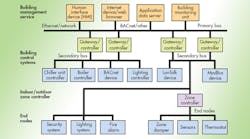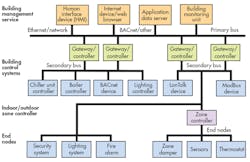Advanced Building-Automation Sensors Save Energy, Enhance Safety.
Download this article in .PDF format
With energy usage and costs being such major issues these days, attention has now turned to commercial buildings that collectively consume about 40% of the nation’s energy budget. Millions of people work in buildings on a daily basis, and they expect a pleasant and secure environment. As a result, organizations spend enormous amounts of money on heating and cooling, lighting, and safety to provide that comfortable atmosphere. Because the costs are so great, even small percentages of savings on energy and security are welcome relief.
One way to garner significant savings is to implement or improve a building automation system that can efficiently monitor and control the building environment. Much of the monitoring capability involves the use of many sensors to detect and measure the physical attributes in the building. With improved sensors, the building automation system can deliver a more fine-grained control of the environment. Some clever new sensors are now available to greatly improve this monitoring and control process.
Building Automation Systems
Building automation systems (BAS) are communications networks that bring together all of the various sensors, actuators, and controlled devices with the computers that implement the system. The overall goals of the system are to save energy and provide a safe, secure, and comfortable work space.
The figure presents a generic version of a BAS. At the top level are the computers and servers that operate the system, store and analyze data, and provide a human interface. At the next lower level are the controlled systems, such as lighting, HVAC, and security. Zone controllers are usually involved at the third level to manage specific indoor or outdoor areas of the building. End nodes at the lowest level are the specific sensors, or actuators, for controlled characteristics like temperature, light level, ventilation, and safety conditions from fire or other hazards.
A high percentage of the buses connecting the various BAS components are based on Ethernet, but may also be RS-485 or CAN serial interfaces. However, with the availability of robust wireless devices nowadays, interfaces like Wi-Fi, ZigBee, sub-1-GHz ISM band designs, and proprietary systems are used for interconnectivity.
The gateways and controllers in the BAS use embedded processors to execute one of several communications protocol standards developed specifically for BAS. These include BACnet, LonMark, and Modbus.
Today, virtually all commercial buildings have some form of BAS. New buildings embed the latest sophisticated systems, while older buildings are retrofitted with the latest equipment compatible with the facilities. Thanks to reliable new wireless equipment such as mesh networks, the retrofitting eliminates costly wiring and simplifies and speeds up installations. In both cases, the end results are worth the investment. For example, one study indicates that building retrofits can decrease operating costs by 13% over five years.
This diagram illustrates a generic building automation system, showing its key elements and their interconnections.
Sensors
Good sensors are the critical elements of all BAS. Temperature sensors for thermostats are the most prolific. They provide the feedback to the heating or air-conditioning system in order to supply the proper level of air flow to each floor or zone.
More systems are now integrating sensors that detect and measure ambient light. If sufficient natural lighting is coming in through windows, artificial lights are turned off or dimmed to save energy. At night or when sunlight decreases, interior lights are turned on or brightened.
The HVAC and lighting make up about 60% of building energy use, so efficient control of them results in massive savings. Generally, the more sensors you deploy, the more options the system has to control smaller zones, which in turn diminishes the waste.
Many other types of sensors are regularly used to preserve air quality or provide safety and security. Humidity sensors, smoke detectors, and infrared (IR) presence sensors, as well as magnetic sensors for window or door breach detection, are common. There are also sensors for carbon monoxide or other toxic gases, let alone dust or pollen.
Two new sensors now available can provide even more precise control. One handles proximity sensing, and the other is involved with people counting.
Proximity Sensing
A key part of all BAS is one or more human machine interfaces (HMIs) that allow an operator to monitor and set control levels throughout the system or in specific zones. These typically employ pushbuttons, keypads, and liquid crystal displays (LCDs). The HMI is not used continuously, so it’s usually in a sleep mode to save energy.
A proximity detector can provide a way to sense the presence of an operator and shorten the wakeup time of the HMI device. The benefits of incorporating a proximity detector in the HMI include the power savings accrued when the unit is not in use, the convenience of locating the HMI in a dark area, and increasing the life of the LCD and backlight.
One type of proximity sensor showing promise over traditional optical or mechanical types is the capacitive sensor. It’s made up of a rectangular sense plate surrounded by a ground shield frame. When a human comes within range of the sensor, the electric field lines are diverted and the capacitance of the sensor changes, triggering the generation of a detection signal.
Such a setup can be made easier with the integration of Texas Instruments’ FDC1004 capacitive-to-digital converter IC. The proximity sensing range is determined mainly by the size of the sensing plate, typically a square copper area on a printed circuit board (PCB). For example, a 3- × 3-cm plate gives a sensing range of 22 cm. A 13- × 13-cm plate offers a range up to 50 cm. The FDC1004 can sense a capacitive change of ±15 pF and support an offset capacitance of up to 100 pF.
In operation, the FDC1004 circuits provide an excitation signal to the capacitor plate. The capacitor’s charge is transferred to a sample/hold circuit and then on to a 16-bit sigma-delta ADC. Threshold detection helps filter the noise pickup on the PCB plate. The ADC output is then sent to a microcontroller via an I2C or SPI interface. The FDC1004 offers four input channels to accommodate up to four sensors. Evaluation modules and a complete reference design (TIDA-00220) are available.
People Counting
People-counting sensors are designed to determine the human occupancy of an area and accordingly adjust the heating or air-conditioning level. Conventional human-detection devices include passive infrared, CO2 level, or video cameras. None of these provide sufficient detail or accuracy to permit efficient control of HVAC levels, though. Texas Instruments’ 3D Time-of-Flight (ToF) reference design, however, offers a way to achieve more accuracy.
The 3D ToF reference design (TIDA-00750) is a two-chip solution to people counting. The OPT8241 is an optical imaging chip, and the OPT9221 is a matching controller that interfaces to an embedded microcontroller. The OPT8241 drives four modulated 855-nm laser diodes that paint the area being monitored. The reflected near IR light from the human objects is captured on an internal 320- × 240-pixel QVGA sensor capable of 120-frame/s operation. The phase shift between the emitted light and captured light is detected and digitized then sent to the OPT9221 controller.
Subsequently, the OPT9221 reconstructs the scene; using optimized algorithms, it creates a 3D output for display. The accuracy of the system allows definitive people counting and even recognizes body movement. In fact, the 3D ToF system is claimed to be more accurate than almost any other human-detection method.



